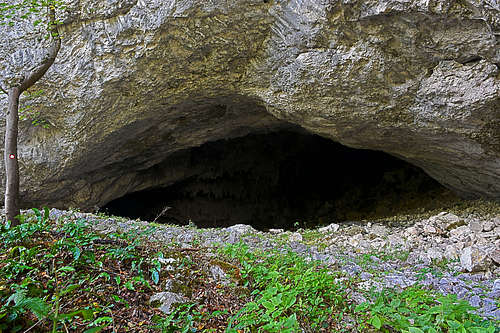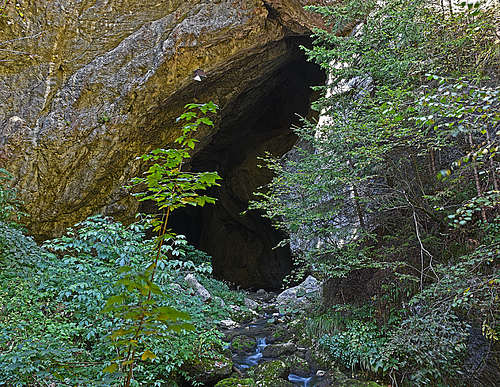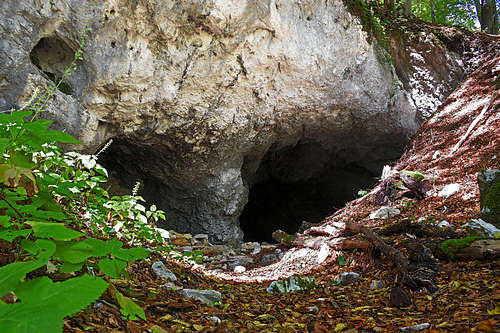-
 1113 Hits
1113 Hits
-
 81.84% Score
81.84% Score
-
 14 Votes
14 Votes
|
|
Custom Object |
|---|---|
|
|
46.41665°N / 15.17212°E |
|
|
page template |
Overview
Also this is not a climbing destination, but it is for sure a hiking one. I'm describing a remote, rarely visited limestone hill with well developed system of karst caves. In addition to beautiful caves, it's also an archaeological site - in all three described caves (altogether it's some 20 of them) artefacts from paleo- and neolithic were found. The area is a part of Karawanks range in a broader sense - actually the foothills of that range. By others, it's a part of the Middle Slovenian Hills.
Geography and Geology

On the east, the higher summits of Karawanks are ending with Uršlja gora. But a tail of lower hills is stretching from that mountain far towards the SE. Through those hills, the small river of Paka has carved a narrow, 1 km long gorge. It was always an important trade connection, so north of the gorge a castle named Waldegg was erected. But today it's all in ruins.
The geological nature of these hills is mixed, but the patch around Tisnik, 786 m, and Pečovnik, 794 m, are all built of quite pure triassic limestone. It's quite a hard rock, but can be easily dissolved by water. If Paka was the one, carving the gorge, then the creek of Ponikva is responsible for creation a dense cave system. Before joining Paka, it goes for a few km underground, and then comes out of the huge cave of Huda luknja.
The Caves

Huda luknja
It's the biggest cave in the system and the main attraction. All caverns are 2339 m long, the upper cavern system is today dry, while the creek flows through the lower one. The big lower portal is seen from the main road, but there the cave entry is closed (by iron gate). Also the guided tours do not go in there. So, even if the cave was arranged for tourist visit even in 1895, today you can enter only accompanied by certified guides. They bring you in the cave system through the upper entry (Lesičina), and the tour turns back in the beautiful Bears Cavern (Medvedji rov). It has a very nice cave decoration and many bones of extinct cave bears can still be seen there. In the lower section also archaeological artefacts from stone age were found and in the cave there's also a specific fauna.
Špehovka cave


It's a smaller cave (only 91 m long), but nice and very interesting due to many archaeological artefacts from paleo- and neolithic, found there (among them also two harpoons). It's entry is on 637 m and if having a reliable battery, you can explore the cave till its last cavern. There, very interesting traces of extinct cave bears can be seen - the places where they were rubbing against rocks, which are now completely polished.

Pilanca Cave
It has the most beautiful portal and the cave itself is quite big - the length is 252 m. In the rear parts interesting cave decoration can be seen - white calcite pillars are in a fine contrast with a bit darker surrounding walls. Also this cave can be explored without danger. Archaeologically the cave has not been fully explored yet. Some artefacts from neolithic (pottery) were found, and even a Roman fibula. But for now that's all. The unexplored status of this cave might add a bit to the exploration thrill, when you are there.
Other Caves
They are smaller, eventually not all of them explored yet. Some are playing role in old legends. The Klet (Cellar) cave (just below the summit of Tisnik hill) is said to be the place where robber knights hid their treasures. The other one is Bolnica (Hospital). There injured partisans were hiding during the World War II. Despite betrayal, the location was never found by Germans, because the entry is so small and hidden in wilderness.
The Route

All three caves (except Huda luknja interior, for which you must hire a guide) can be reached by a marked trail. It's a part of Šaleška planinska pot, the trail encircling the whole Šaleška dolina (valley). We park some 300 m south of Huda luknja lower portal. There's a free parking place and also the Speleologists' hut. The parking lot can be reached by the road which connects Mislinja town with Velenje town.
From the parking lot, the marks lead us towards the north. The route simply follows the ex railway, which went just a few meters above the main road. Before the tunnel, we reach the Huda luknja lower portal. There we go left down the ex railway, visit the cave and then go below the railway to the road. Then left - along the main road (unpleasant due to traffic).
On the place where the main road crosses the Paka river, at the end of the bridge we must deter left. The marked path goes steeply uphills, till a high limestone crag, where it turns left. Then in a not too steep ascent through the woods up, till a big right turn. After the turn it goes up again, then in a few short turns just to the high, completely smooth crag. On it's right side, there's the entry into the Špehovka cave. Explore the cave.
From Špehovka, we continue towards the north (right). After a short ascent, the trail becomes weaker, crosses a not too distinct forest ridge and continues crossing over the slopes. Soon we reach another high crag. We climb up to it - there's the big entry into the Pilanca cave. Explore the cave as you can.
The first, horizontal part of the hike is some 10 minutes. From the bridge end, up to the Pilanca cave, it's some 20 minutes. The path is all the time quite easy and well beaten, only on a few places it requires a more safe step. On the Swiss Hiking Scale the overall grade would still be T2. Regarding the time needed, have in mind that you will spend two times more time for exploring caves than for walking. Altogether, devoting 2 hours should be enough.
You return to the parking place by the same route.

